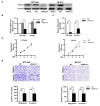Rab14 Suppression Mediated by MiR-320a Inhibits Cell Proliferation, Migration and Invasion in Breast Cancer
- PMID: 27994670
- PMCID: PMC5166543
- DOI: 10.7150/jca.15737
Rab14 Suppression Mediated by MiR-320a Inhibits Cell Proliferation, Migration and Invasion in Breast Cancer
Abstract
We found that microRNA-320a (miR-320a) was an attractive prognostic biomarker in breast cancer (BC) previously, whereas its regulatory mechanism in BC was not well understood. Our aim was to identify miR-320a target gene, examine the clinical relationship between miR-320a and its target, and further explore the functions of its target in BC. In this study, miR-320a downstream target gene was determined in HEK-293T cells by dual luciferase reporter assay. Then western blotting and immunohistochemistry were used to assess miR-320a target gene expression in fresh frozen (n=19, breast cancer and matched non-malignant adjacent tissue samples) and formalin-fixed paraffin-embedded (FFPE) (n=130, invasive BC tissues, the same panel detected for miR-320a expression previously) breast tissues, respectively. The results suggested that miR-320a could significantly suppressed Rab14 3'-untranslated region luciferase-reporter activity, and thus Rab14 was first identified as miR-320a target in BC. In 19 matched breast tissues, 12 (63%) breast cancer tissues showed high expression of Rab14 compared with the corresponding normal tissues. Rab14 immunoreactivity was mainly detected in the cytoplasm, 77/130 (59.2%) showed high expression. Furthermore, Rab14 expression was found to be inversely correlated with miR-320a expression in fresh-frozen breast tissues as well as in FFPE invasive breast cancer samples. In addition, Rab14 expression levels were positively related to tumor size (P = 0.034), lymph node metastasis (P < 0.001), distant metastasis (P = 0.001), histological grade (P = 0.035) and clinical tumor lymph-node metastasis stage (P = 0.001). Patients with higher Rab14 expression showed shorter overall survival time. Moreover, silencing of Rab14 could suppress proliferation, migration and invasion in breast cancer cell lines. Collectively, our results indicate that miR-320a could target Rab14 and that they could interact biologically in BC.
Keywords: Rab14; breast cancer; invasion.; miR-320a; migration; proliferation.
Conflict of interest statement
The authors declare that they have no competing interests.
Figures




Similar articles
-
MicroRNA-320a inhibits proliferation and invasion of breast cancer cells by targeting RAB11A.Am J Cancer Res. 2015 Aug 15;5(9):2719-29. eCollection 2015. Am J Cancer Res. 2015. PMID: 26609479 Free PMC article.
-
miR-320a serves as a negative regulator in the progression of gastric cancer by targeting RAB14.Mol Med Rep. 2017 Sep;16(3):2652-2658. doi: 10.3892/mmr.2017.6937. Epub 2017 Jul 6. Mol Med Rep. 2017. PMID: 28713899 Free PMC article.
-
MicroRNA-320a inhibits breast cancer metastasis by targeting metadherin.Oncotarget. 2016 Jun 21;7(25):38612-38625. doi: 10.18632/oncotarget.9572. Oncotarget. 2016. PMID: 27229534 Free PMC article.
-
miRNA-320a inhibits tumor proliferation and invasion by targeting c-Myc in human hepatocellular carcinoma.Onco Targets Ther. 2017 Feb 15;10:885-894. doi: 10.2147/OTT.S122992. eCollection 2017. Onco Targets Ther. 2017. PMID: 28243124 Free PMC article.
-
Emerging role of miR-320a in lung cancer: a comprehensive review.Biomark Med. 2023 Sep;17(18):767-781. doi: 10.2217/bmm-2023-0215. Epub 2023 Dec 14. Biomark Med. 2023. PMID: 38095986 Review.
Cited by
-
MicroRNA-451 dictates the anoikis resistance of osteosarcoma by targeting Rab14.Int J Clin Exp Pathol. 2017 Nov 1;10(11):10989-10997. eCollection 2017. Int J Clin Exp Pathol. 2017. PMID: 31966443 Free PMC article.
-
MicroRNA 320, an Anti-Oncogene Target miRNA for Cancer Therapy.Biomedicines. 2021 May 23;9(6):591. doi: 10.3390/biomedicines9060591. Biomedicines. 2021. PMID: 34071109 Free PMC article. Review.
-
Improved Loading of Plasma-Derived Extracellular Vesicles to Encapsulate Antitumor miRNAs.Mol Ther Methods Clin Dev. 2019 Jan 9;13:133-144. doi: 10.1016/j.omtm.2019.01.001. eCollection 2019 Jun 14. Mol Ther Methods Clin Dev. 2019. PMID: 30788382 Free PMC article.
-
LINC00460 Facilitates Cell Proliferation and Inhibits Ferroptosis in Breast Cancer Through the miR-320a/MAL2 Axis.Technol Cancer Res Treat. 2023 Jan-Dec;22:15330338231164359. doi: 10.1177/15330338231164359. Technol Cancer Res Treat. 2023. PMID: 36938678 Free PMC article.
-
microRNAs Mediated Regulation of the Ribosomal Proteins and its Consequences on the Global Translation of Proteins.Cells. 2021 Jan 8;10(1):110. doi: 10.3390/cells10010110. Cells. 2021. PMID: 33435549 Free PMC article. Review.
References
-
- Siegel R. et al. Cancer statistics, 2014. CA: A Cancer Journal for Clinicians. 2014;64(1):9–29. - PubMed
-
- Krol J. et al. The widespread regulation of microRNA biogenesis, function and decay. Nat Rev Genet. 2010;11(9):597–610. - PubMed
-
- Lewis B.P. et al. Conserved Seed Pairing, Often Flanked by Adenosines, Indicates that Thousands of Human Genes are MicroRNA Targets. Cell. 2005;120(1):15–20. - PubMed
-
- Fang Y. et al. MicroRNA-7 inhibits tumor growth and metastasis by targeting the phosphoinositide 3-kinase/Akt pathway in hepatocellular carcinoma. Hepatology. 2012;55(6):1852–62. - PubMed
LinkOut - more resources
Full Text Sources
Other Literature Sources
Miscellaneous

